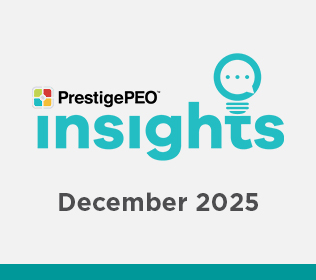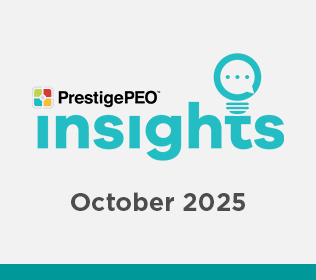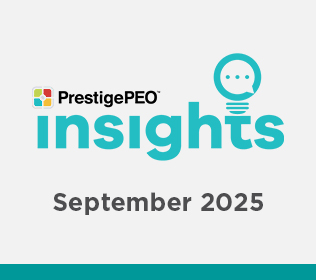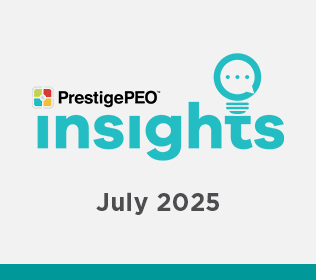
The latest news relevant to you and your business
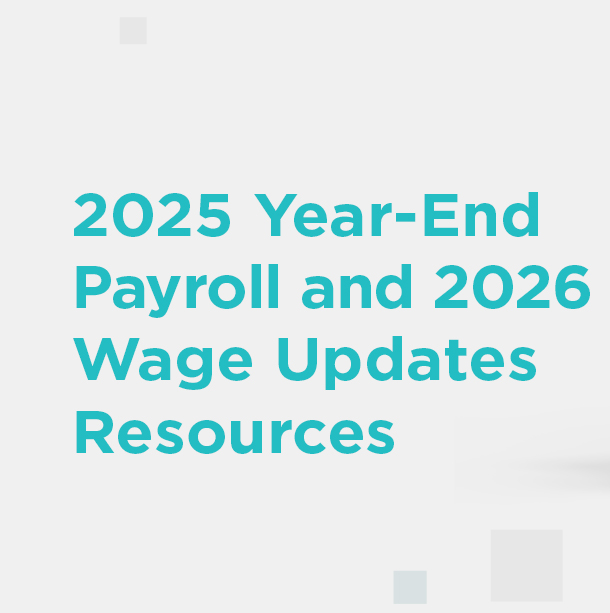
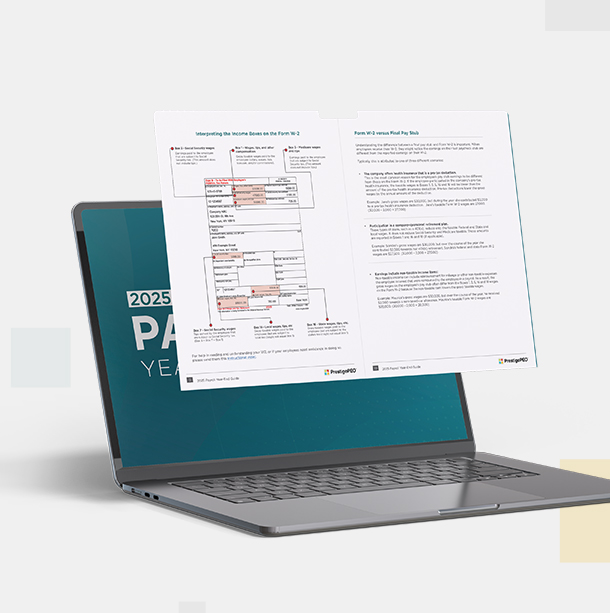
Plan Ahead with PrestigePEO’s 2025 Year-End Payroll & 2026 Wage Guides
As the year approaches to an end, it’s time to prepare your business for a smooth transition into 2026. PrestigePEO’s 2025 Year-End Payroll Guide and 2026 Minimum Wage and Salary Threshold Updates Guide provide the insights and checklists you need to stay compliant and organized.
From processing final payrolls and verifying employee data to understanding upcoming changes to minimum wage and exemption thresholds, these guides outline every key update that impacts your business.
Use these resources to simplify your year-end responsibilities, avoid compliance pitfalls, and ensure your organization is fully prepared for the new year.
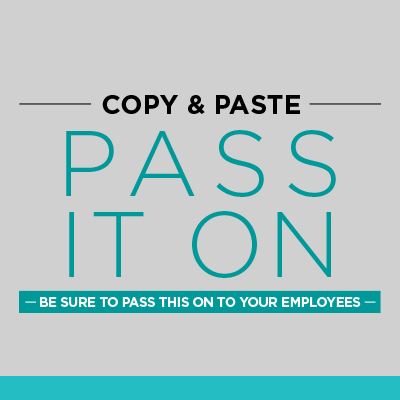
Go Digital: Access Your W-2 Faster and Easier
The end of the year is approaching. Make tax season easier by enrolling in electronic W-2 access through your PrestigePRO Employee Self-Service portal.
Electronic W-2s are typically available 2–3 weeks earlier than paper forms and can be viewed and downloaded at any time.
To enroll, simply:
- Log in to your PrestigePRO Employee Self-Service account.
- Select the “Taxes” tab, then “W-2.”
- Review the Early W-2 Election Terms, check the consent box, and click Enroll.
Enroll by December 31, 2025, to receive your W-2 electronically quickly, securely, and without waiting for mail delivery. For assistance, reach out to your Payroll Specialist.
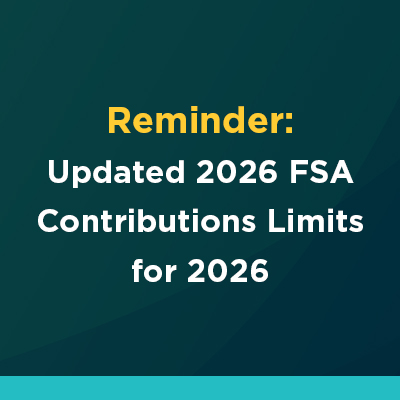
Reminder: Updated 2026 FSA Contributions Limits for 2026
IRS Announces Higher FSA Contribution Limits for 2026
The IRS has announced updated contribution limits for Flexible Spending Accounts (FSA) for the 2026 plan year.
- The Health FSA limit increases to $3,400 (up from $3,300 in 2025).
- The Dependent Care FSA limit significantly rises to $7,500 ($3,750 for married individuals filing separately).
- The carryover limit for Health FSAs will also increase to $680.
If you’re enrolled in an FSA or plan to participate in 2026, now is a great time to review your elections and ensure your contributions reflect these updated limits.
- Don’t forget: March 31, 2026, is the last day to submit reimbursement claims for 2025 expenses.
For any questions or assistance with updating your FSA elections, please contact your PrestigePEO Benefits Specialist.

Your Partner in Compliance and Workforce Protection
From evolving state laws to new federal requirements, PrestigePEO keeps you informed every step of the way. This month’s compliance insights provide clear, practical direction to help you safeguard your business and support your people with confidence.
- 2025-2026 Guide-Major State Paid Leave Rules
- California Employment Law Updates for 2026
- Illinois Expands Employee Protections in Employment Practices
- Maryland FAMLI Updates
- Montana Restricts Non-Competes
- Neurodiversity and the ADA
- Nevada Establishes Safety Requirements to Protect Employees from Wildfire Smoke
- New DHS Rules Ends Automatic Work Permit Extensions: What Employers and Workers Must Do Now
- New Jersey Bands Captive Audience Meetings
- New York City Expands Earned Safe and Sick Time Act: What Employers Must Do Before February 2026
- Oregon Strengthens Workplace Violence Protections for Health Care and Behavior Health Workers
- Pennsylvania Veteran Benefits Posting Requirements
- Rhode Island Employers Must Provide Written New Hire Notices
- Rhode Island Expands Leave and Disability Benefits
- Secure Choice Retirement Saving Program Launches in New York
- Texas’ New AI Law Brings Major Compliance Duties for Employer
- The Clock Is Ticking to January 1: Your 2025–2026 Guide to Major State Paid Leave Rules;
- Washington Establishes Safety Requirements for Isolated Employees
To learn more about previous compliance updates, visit the Client Resource Center, select “managers,” and click the Compliance section.
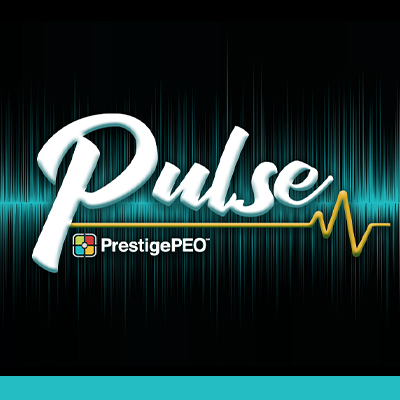
PrestigePEO Pulse Newsletter: Year-End Employee Updates
Keep Your Team Informed with the PrestigePEO Pulse Newsletter
Each December, PrestigePEO shares our annual Pulse Newsletter with your employees, a helpful, year-end resource designed to keep them informed and empowered.
The upcoming 2025 edition will include important information on accessing W-2 forms, maximizing Flexible Spending Account (FSA) benefits, and utilizing features in the PrestigeGO mobile app.
If you prefer that your employees NOT receive the Pulse Newsletter, please click the Opt-Out link below to update your preferences.
Note: Complete the opt-out form by Wednesday, December 10, 2025.

Post-Open Enrollment Tips
Your New Benefits Are Here – What to Expect Next
Your 2026 benefits are now in effect as of November 1, 2025!
Here are a few necessary next steps and reminders to help you get the most from your coverage:
- Watch for new ID cards: You’ll receive new insurance ID cards by mail from your carrier within the next few weeks, even if you didn’t make any plan changes.
- Review your paycheck deductions: Verify that your benefits deductions are accurate. If you notice any discrepancies, please get in touch with your Benefits Specialist immediately.
- Download your carrier’s mobile app: Most carriers offer easy access to your digital ID cards, claims, and coverage details through their apps.
- Changes outside Open Enrollment: After OE ends, changes can ONLY be made if you experience a qualifying life event (e.g., marriage, birth/adoption, loss of coverage).
- Stay connected: Keep your carrier contact information handy and watch for upcoming wellness initiatives and benefits resources from PrestigePEO.
If you have any questions or need assistance, please reach out to your dedicated Benefits Specialist. We’re here to help ensure a smooth transition into the new plan year.

Introducing Enhanced Data Reporting at PrestigePEO
Visualize Your Workforce Data Like Never Before
PrestigePEO’s enhanced reporting experience, powered by PrismHR’s Data Warehouse and Sigma Computing integration, transforms complex data into clear, actionable insights to help guide smarter business decisions.
The new Report Center delivers:
- Faster performance and dynamic data visualizations
- Built-in security and compliance safeguards
- Flexible, customized reporting aligned with your business needs
Even better, your reports can now be embedded directly within the Manager Self-Service Portal, giving you secure access to key insights right where you work.
From workforce trends to payroll analytics, PrestigePEO’s enhanced reporting helps you visualize, analyze, and act with confidence.
Connect with your HR Business Partner (HRBP) today to identify the data most valuable to your organization and start building customized reports that bring your story to life.

AI, Compliance, and HR: Guidance for Business Owners & HR Leaders
Missed Our Webinar on AI, Compliance, & HR? Watch Now!
If you missed our live session on “AI, Compliance & HR: Guidance for Business Owners & HR Leaders”, now’s your chance to catch up.
In this webinar, our expert panel tackled:
- How AI is reshaping HR operations and business workflows
- The evolving compliance landscape — Title VII, EEOC guidance, and state-level regulations
- Practical frameworks to implement AI responsibly and mitigate risks like bias and fairness
- What’s next in HR tech — preparing for agentic AI and emerging tools
Click to view the complete recording and equip your organization with the insights you need to stay ahead. Contact your HRBP to discuss how to apply these insights within your business.

ADA Compliance in Action
ICYMI: ADA Compliance Strategies for Today’s Workplace
In case you missed our live session on ADA compliance, you can now access the full recording of “ADA Compliance in Action – Practical Strategies for Today’s Workplace.”
Our experts reviewed:
- Practical employer obligations under the Americans with Disabilities Act (ADA) and how to implement the interactive process with confidence.
- Coordination of ADA with FMLA, workers’ compensation, and state leave laws, including key emerging trends for 2025.
- How growing businesses can proactively manage disability-related risks while maintaining inclusive and compliant workplace practices.
Watch the recording and equip your organization with the insights needed to stay ahead.

Effortless Recruiting Starts with JazzHR
The Smart Hiring Platform for Growing Businesses
JazzHR’s powerful, easy-to-use applicant tracking system (ATS) is now available through PrestigePEO, providing a streamlined recruiting tool integrated with the rest of your HR platform.
Post job openings with one click, track candidates, collaborate with hiring teams, manage offers and eSignatures, and generate compliance-ready reports, all in one place.
With unlimited users, mobile access, and full-service support from your PrestigePEO HR team, JazzHR helps you attract talent faster, reduce hiring risk, and stay focused on growing your business.

Smart Expense Management for Growing Businesses
Simplify Expense Reporting with ExpensePath
ExpensePath is a fully digital expense reporting tool designed for businesses. From receipt capture and expense submission to manager approvals and payroll integration, ExpensePath automates the entire process, saving time, reducing errors, and freeing up your team to focus on what matters.
With built-in policy control, mobile access, and seamless integration with payroll data, this solution empowers employees spending oversight and cost management. Pair it with your PrestigePEO HR and payroll services for a streamlined, end-to-end experience.
Know a business that could benefit from stronger HR support, premium employee benefits, and expert compliance guidance?
Refer them to PrestigePEO and earn up to $2,500 for every successful referral, with NO LIMIT on how many you can make.
Every connection is an opportunity to help another business thrive while earning rewards for yourself.

Your Partner in Compliance and Workforce Protection
From evolving state laws to new federal requirements, PrestigePEO keeps you informed every step of the way. This month’s compliance insights provide clear, practical direction to help you safeguard your business and support your people with confidence.
Additional State Updates for November 2025
- Indiana: Effective January 1, 2026, the Earned Wage Access (EWA) law will allow employees to access earned but unpaid income through providers offering earned wage access services. State regulations guide how these financial services may be offered, with the emphasis on consumer protection.
- Maine: Effective January 1, 2026, minimum wage regulations take effect for agricultural workers requiring that all agricultural workers be paid at least minimum wage.
- Minnesota: Effective January 1, 2026, new meal and rest break requirements will require employers to allow employees a break time of the longer of 15 minutes or enough time to utilize the closest restroom facilities, during every four hours worked and 30 minutes for meal breaks for employees that work at least 6 consecutive hours.
PrestigePEO is here to help. For guidance on this new regulation or any other questions, please contact your HRBP for help.
California Employment Law Updates for 2026
This year, California’s Governor Newsom signed several new bills aimed at expanding California worker protections, resulting in increased employer obligations. Highlighted below are the changes employers will need to review and plan to update their policies accordingly, with many of these new laws taking effect January 1, 2026.
Personnel Records to Include Education or Training Records
Effective January 1, 2026, SB 513 amends the Labor Code to require employers to provide employees with access to their education or training records, in addition to existing personnel records. These records must include: (1) employee name; (2) training provider; (3) training date and duration; (4) core competencies, including equipment or software skills; and (5) certification or qualification earned. All other requirements remain, such as making records available within 30 days of a written request and suspending the right to inspect during related lawsuits against the employer or former employer.
WARN Notice Revisions
Effective January 1, 2026, SB 617 amends the written notice requirement provided for a mass layoff, relocation, or termination pursuant to the California Worker Adjustment and Retraining Act to include: (1) information on whether the employer plans to coordinate rapid response services through the local workforce development board or another entity, along with a specific contact information; (2) information regarding CalFresh, the statewide food assistance program; (3) standardized job placement/retraining language; and (4) employer contact details.
Stay-or-Pay Employment Contract Repayment Requirements Unlawful
AB 692 adds limitations to the Business and Professions Code and will apply to all employers and all employment contracts entered into, on, or after January 1, 2026, prohibiting the inclusion of any term or conditions of the employment contract that require a worker to pay an employer, training provider, or debt collector for a debt or repay fees or costs incurred by an employers on the employee’s behalf should the worker’s employment or work relationship with a specific employer terminates. Narrow exceptions related to tuition repayment, bonuses, apprenticeship programs, and others exist, but employers are encouraged to fully understand these exceptions and all associated penalties for non-compliance. Violations of Section 16608 are considered void as contrary to public policy.
Penalties for non-compliance include the right for any worker subjected to such a contract or contract term to bring a private civil cause of action on behalf of that worker, or other persons similarly situated, to court. Employer may be liable for actual damages sustained by the worker or workers on whose behalf the case is brought, or five thousand dollars ($5,000) per worker, whichever is greater, as well as injunctive relief, and reasonable attorney’s fees and costs
Pay Equity and Data Reporting
Equal Pay Act Amendments
Effective January 1, 2026, Section 432 of the Labor Code changes the term “pay scale” in job posting requirements to a “good faith estimate of the salary or hourly wage range that the employer reasonably expects to pay for the position upon hire.” The bill also revises Section 1197.5 of the Labor Code, which prohibits employers from paying employees at wage rates lower than those paid to employees of another sex for substantially similar work, subject to certain exceptions. SB 642 replaces “opposite” with “another” sex and defines “wages” and “wage rates” to include various forms of pay, such as salary, overtime pay, bonuses, stock options, profit sharing and bonus plans, life insurance, vacation and holiday pay, cleaning or gasoline allowances, hotel accommodations, reimbursement for travel expenses, and benefits. The bill also enlarges the statute of limitations from two to three years for pay equity claims and provides for the recovery of lost wages during the entire duration of the violation, up to six years.
Employee Pay Data Reporting Expanded
Under existing law, private employers with 100 or more employees are required to submit annual pay data reporting to the Civil Rights Department (CRD). This report must detail the number of employees by race, ethnicity, and sex across ten specified job categories, indicate the distribution of employees by these demographics within federal pay bands, provide the median and mean hourly rates for each group within every job category, and record the total number of hours worked by each employee reported in each pay band. The submission deadline for this report is the second Wednesday in May each year, which for the upcoming cycle falls on May 13, 2026.
With the enactment of SB 464, California has enhanced its employer obligations concerning pay data reporting. The new legislation introduces several significant updates: (1) demographic information collected must now be gathered and stored separately from employees’ personnel records; (2) the statutory language regarding civil penalties has been revised to state that courts “shall” impose a civil penalty of up to $100 per employee for noncompliance and $200 per employee for subsequent violations at the request of the CRD, replacing the previous discretionary “may”; and (3) effective January 1, 2027, the scope of job categories requiring reporting will expand from ten to twenty-three.
Expanded PFL Benefits to Include Care for Designated Person
Beginning July 1, 2028, California’s Paid Family Leave (PFL) will expand coverage to employees who take time off to care for a seriously ill “designated person,” defined as someone related by blood or with a family-like relationship, as well as a family member. Employees must identify this person when applying for benefits and confirm the relationship under penalty of perjury.
Further Revisions to Victim Protections
AB 2499 updates California’s victim-of-violence workplace protection laws under the California Fair Employment and Housing Act (FEHA) to cover family members of victims and allow paid sick leave for qualifying violence-related reasons, effective immediately.
Penalties for Unpaid Wage Judgments
Additions to the Labor Code under SB 261 state that if a final judgment resulting from nonpayment of wages for work performed in California remains unsatisfied for 180 days after the appeal period has ended and no appeal is pending, the judgment debtor may be subject to a civil penalty of up to three times the outstanding judgment amount, including post-judgment interest. The court is required to assess the full penalty unless it determines, based on clear and convincing evidence, that there is good cause to reduce the penalty amount. Penalties are distributed equally between the employee(s) benefiting from the judgment and the DLSE.
Additionally, SB 261 grants the prevailing plaintiff reasonable attorney’s fees and costs in any action brought by a judgment creditor, the Labor Commissioner, or a public prosecutor to enforce a final judgment related to unpaid wages, penalties, or other amounts owed for work performed in California, or to encourage compliance or impose lawful consequences on a judgment debtor who has not satisfied such a judgment.
Labor Commissioner to Enforce Gratuity Law Violations
The Labor Code currently states that “[n]o employer or agent shall collect, take, or receive any gratuity or a part thereof that is paid, given to, or left for an employee by a patron, or deduct any amount from wages due an employee on account of a gratuity, or require an employee to credit the amount, or any part thereof, of a gratuity against and as a part of the wages due the employee from the employer.” SB 648 amends this portion of the Labor Code to allow the Labor Commissioner to investigate and issue a citation or file a civil action “for gratuities taken or withheld in violation of this section.”
Expansion of PERB to Private Sector Workers
Effective January 1, 2026, AB 288 addresses the limitations of the current National Labor Relations Board (NLRB) by expanding the California Public Employment Relations Board’s (PERB) authority to process representation petitions and unfair labor practice cases. Workers may petition PERB if their position loses coverage under the National Labor Relations Act (NLRA) due to changes in the Act or if the NLRB “expressly or impliedly ceded jurisdiction,” such as by delaying a case for over 12 months. The bill also allows the California Agricultural Labor Relations Board (ALRB) to treat NLRA precedents as persuasive but not binding. On October 15, 2025, the NLRB sued California and PERB, claiming AB 288’s jurisdictional expansion is preempted by the NLRA. (National Labor Relations Board v. State of California, E.D. Cal. Case No. 2:25-at-01400).
Transportation Network Company Drivers Labor Relations Act
Effective January 1, 2026, the Transportation Network Company Drivers Labor Relations Act grants TNC drivers the right to form, join, organize, and participate in driver organizations, bargain collectively, engage in concerted activities for mutual benefit, or abstain from such actions. A “TNC driver” is anyone using their personal vehicle with a TNC’s app or platform to transport passengers in California, while a “TNC” refers to an entity that offers paid, prearranged transportation via an online-enabled platform per the Public Utilities Code. The law also requires TNCs to submit quarterly reports to PERB and establishes procedures for certifying and decertifying driver organizations, among other provisions. TNCs will also be required to negotiate in good faith with certified driver bargaining organizations and provide notices to TNC drivers about union organization and representation.
Transparency in Frontier Artificial Intelligence Act
Effective September 29, 2025, the Transparency in Frontier Artificial Intelligence Act (TFAIA), sets transparency and reporting rules for frontier developers. It prohibits policies that block or punish employees from reporting risks or violations, offers whistleblower protections, and requires large developers to provide an anonymous internal reporting process.
Bias Mitigation Training Does Not Constitute Discrimination
California has passed legislation, effective January 1, 2025, that encourages employers to provide bias mitigation training by clarifying that if an employee acknowledges personal bias in good faith during such training, it is not considered unlawful discrimination. Bias mitigation training refers to employer-led programs aimed at helping employees recognize and reduce the effects of their conscious and unconscious biases through targeted strategies. This law amends the California Fair Employment and Housing Act (FEHA), which requires harassment prevention training.
Workplace Know Your Rights Act
The Workplace Know Your Rights Act mandates that California employers provide each employee with a standalone written notice detailing specified workplace rights by February 1, 2026, and on an annual basis thereafter. The required notice must include, among other elements, information regarding workers’ compensation benefits, procedures for inspections by immigration agencies, protections against unfair immigration-related practices, the right to unionize or participate in concerted workplace activities, and constitutional rights when engaging with law enforcement at work.
In order to facilitate compliance, the Labor Commissioner will publish a template notice on its website by January 1, 2026. Employers must deliver this notice using their customary communication method for employment-related matters; additionally, they are required to furnish the notice to new hires and authorized representatives via electronic means or regular mail.
This new legislation further requires employers to offer existing employees the opportunity to designate an emergency contact by March 30, 2026, and at the time of hire for new employees. Employees must be permitted to update their emergency contact information throughout their employment and specify whether the emergency contact should be notified if the employee is arrested or detained at the worksite, during work hours, or while performing job duties offsite, provided the employer has actual knowledge of such incidents. If consent is given, the employer is obligated to notify the designated emergency contact in the event of an arrest or detention on the worksite. The Act includes anti-retaliation provisions that protect employees exercising or attempting to exercise rights under the law.
The Act authorizes the Labor Commissioner or public prosecutors to enforce compliance, including seeking temporary or preliminary injunctive relief, punitive damages, and reasonable attorneys’ fees and costs. Employers found in violation of the Act may face penalties of up to $500 per employee per violation. For violations relating to emergency contact requirements under the Labor Code, penalties may reach $500 per employee per day, capped at $10,000 per employee. Statutory penalties paid to employees or civil penalties may be recovered, but only one type of penalty applies per violation. The Act allows its requirements to be superseded by a collective bargaining agreement, provided any waiver is specifically articulated in clear and unambiguous terms within the agreement.
Los Angeles Hotel Worker Training Ordinance (HTO)
Effective December 1, 2025, all Los Angeles, California hotel employers with sixty or more guest rooms will be required to provide housekeeping training consisting of at least six hours from a certified third-party training provider. Training topics should include hotel worker rights and employer responsibilities, best practices for identifying and responding to suspected human trafficking and identifying and responding to other potential criminal activity, domestic violence, or violent or threatening conduct, and best practices for effective cleaning techniques to prevent the spread of disease and identifying and avoiding insect or vermin infestations. These new training requirements are part of the existing Hotel Worker Protection Ordinance (HWPO) and will require employers to cover the cost of the training as well as the employees’ time while taking the necessary training.
PrestigePEO is here to help. If you have questions about these new regulations, please contact your HRBP for assistance.
Illinois Expands Employee Protections in Employment Practices and Agreements
Effective January 1, 2026, amendments to the Illinois Workplace Transparency Act (WTA) expand employee protections and impose new restrictions on employment-related agreements. These changes apply to employment contracts, offer letters, settlement agreements, separation agreements, and other similar agreements entered into, modified, or extended on or after that date. However, collective bargaining agreements are not affected.
The amendments broaden the definition of “unlawful employment practices” to include not only discrimination and harassment but also workplace safety violations, wage and hour violations, and other rights enforced by state or federal agencies such as the Illinois Department of Labor, OSHA, and the National Labor Relations Board. Agreements cannot prevent employees from reporting violations, discussing workplace issues, or engaging in collective or concerted activity.
Confidentiality provisions in settlement or separation agreements must now be supported by separate, bargained-for consideration and cannot restrict employees’ rights to participate in legal or administrative proceedings. Employers are also prohibited from including unilateral terms that shorten limitation periods, apply non-Illinois law, or require disputes to be resolved outside Illinois, unless these terms are mutually negotiated.
Employees may recover consequential damages in addition to attorney’s fees and costs if they successfully challenge an agreement that violates the WTA.
Employers should review all employment-related agreements, settlement or separation documents, and consult with legal counsel to ensure employment agreements are compliant.
PrestigePEO is here to help your business maintain compliance and stay ahead of the curve. Please contact your Human Resources Business Partner with any questions.
Montana Has Joined the Growing List of States to Restrict Non-Competes
Since April 2025, Montana has enacted two laws restricting non-compete and non-solicit agreements for healthcare providers in the state. This increased legislation built on the existing ban on non-competes and non-solicitation agreements as applied to a variety of different healthcare providers, including psychiatrists or addiction medicine physicians, psychologists, social workers, professional counselors, addiction counselors, marriage and family therapists, and behavioral health peer support specialists.
The first law, effective mid-April 2025, enlarged the existing law to include naturopathic physicians, registered professional nurses, advanced practice registered nurses, and physician assistants, but did not apply to the sale or purchase of a medical practice. The second law, effective January 1, 2026, bans such agreements for all licensed physicians, with exceptions for contracts related to medical practice sales and repayments of loans, relocation costs, signing bonuses, educational expenses, and tuition reimbursement.
PrestigePEO is here to help. If you have question regarding this new legislation, please contact your HRBP for support.
Maryland Department of Labor Reissues Family and Medical Leave Insurance (FAMLI) Program Proposed Regulations
After several delays to the implementation and start of the Family and Medical Leave Insurance (FAMLI) Program, the Maryland Department of Labor reissued proposed regulations, on October 17, 2025, which are open to public comment through November 17, 2025. While most of the substantive portions of the regulations are the same as previous versions, there are some key changes to the regulations reissued in October.
Some key changes include, but are not limited to, timelines for employers to notify employees prior to the beginning of contribution withholdings/changes to withholding amounts; stricter enforcement and penalties for contribution delinquencies; a formal dispute resolution process for employers relating to contribution liabilities; updated timelines and procedures for the approval of Equivalent Private Insurance Plans; and various defined terms updates.
PrestigePEO is here to help and will continue to monitor updates from the Maryland Department of Labor. Once the public comment period expires, additional updates will be provided once the proposed regulations are finalized for Maryland’s FAMLI program. Please contact your Human Resources Business Partner with any questions.
The ADA and Neurodiversity
Neurodiversity is the way to describe the nature in which individuals learn, think, perceive the world, and interact with and process information. The term is often used to describe those individuals on the autism spectrum, but it traditionally includes a wide range of people who have a variety of cognitive, intellectual, developmental, and neurological conditions that shape how they learn and think. Some other examples include individuals with ADHD, individuals with PTSD, individuals with learning disabilities such as dyslexia, and those with other mental health conditions.
The term neurodiversity has become much more commonplace in the last 20-25 years as people have become not only more aware and understanding of these differences but have become much more accommodating as well. The rise in understanding and acceptance of neurodiversity has been accompanied by two important factors: the passage and expansion of the Americans with Disabilities Act (ADA) and its workplace protections and the increase in Equal Employment Opportunity Commission merit resolutions involving autism and other neurological conditions. From 2015 to 2023, the number of merit resolutions involving autism-related ADA claims has risen from .2% to over 1.5% percent with other claims involving other neurological impairments rising by .5%. This indicates both a growing recognition of neurodiversity in the workplace and the need to protect and provide reasonable accommodations for those individuals. The rise in these claims has been driven by a variety of factors such as increased awareness, recognition and acceptance, improved diagnostic and identification, and greater understanding and reduction of stigma surrounding neurodiversity.
With the prevalence of these trends in neurodiversity, employers must be more aware and supportive of employees who may have a neurodiverse diagnosis. The ADA protects employees from discrimination based on physical and mental disabilities including many types of neurodivergence. The ADA defines a person with disability as someone who has a physical or mental impairment that substantially limits one or more major life activities, has a history or record of such an impairment, or is perceived by others as having such an impairment. Employers therefore have a duty under the ADA to ensure that neurodiverse employees have the reasonable accommodations they need to perform their jobs and to protect them from bias.
When addressing accommodations for a neurodiverse employee, employers should consider a few key questions (as outlined by the Job Accommodation Network):
- What limitations are the employee experiencing?
- How do these limitations affect the employee and the employee’s job performance?
- What specific job tasks are problematic as a result of these limitations?
- What accommodations are available to reduce or eliminate these problems? Are all possible resources being used to determine possible accommodations?
- Once accommodations are in place, would it be useful to meet with the employee to evaluate the effectiveness of the accommodations and to determine whether additional accommodations are needed?
- Do supervisory personnel and employees need training?
If any employee does meet the definition of disability under the ADA, then employers should look to make accommodations on a case-by-case basis for not just employees with neurodivergence, but for all employees that may be covered.
The questions provided above should be accompanied by some of the considerations listed below to ensure that the appropriate accommodations can be provided.
Considerations for recruitment and hiring
- Fewer interviewers in a single setting
- Detailed instructions or note cards
- Interview questions provided in advance
- A job coach or family member as a support person
- Alternate assessments and/or demonstration of actual job skills and related talents
- Informational phone interview held before traditional interview
Considerations for sustaining employment
- Traditional and peer mentoring
- Frequent and ongoing manager feedback and positive reinforcement
- Service or emotional support animal use
- Remote work with needed assistive technology
- Job task restructuring
- Workplace policy modifications, including flexible breaks
- Workplace modifications for sensitivities involving light, noise, and temperatures
- Employee Assistance Program (EAP) support
- Skills training
If an employee or employer has any questions about how to determine whether a person has a disability under the ADA, they may look into the Americans with Disabilities Act Amendments Act for more guidance.
As always, PrestigePEO is here to help with any ADA and accommodation needs. For questions regarding these regulations or other matters, please contact your HRBP for assistance.
Nevada Enacts Safety Requirements to Protect Employees from Wildfire Smoke
Effective January 1, 2026, Nevada will require certain employers to monitor air quality and take steps to reduce employee exposure to wildfire smoke. The regulations apply to private businesses and government employers at the state or local level with more than 10 employees who work outdoors. Employers with 10 or fewer employees, or those in mining, commercial trucking, or emergency services, are generally exempt.
Covered employers must:
- Monitor air quality using tools such as the EPA AirNow app, EnviroFlash subscriptions, or direct-reading PM2.5 sensors.
- Take action when the Air Quality Index (AQI) reaches 150 or higher.
- Limit outdoor activities by preventing employees from doing important tasks when the air quality is bad.
- Establish a communication system to alert employees about hazardous AQI levels and receive reports of symptoms, like difficulty breathing or chest discomfort.
- Provide training to ensure employees understand the risks of wildfire smoke, know how to use PPE, and can recognize exposure symptoms.
Nevada enacted these requirements to protect workers from the known health hazards of wildfire smoke, which can include respiratory problems, asthma attacks, and cardiovascular issues. The Division of Industrial Relations will issue additional guidance on compliance, including considerations for rural and remote worksites.
Employers should prepare by acquiring AQI monitoring tools, ensuring sufficient PPE is available, establishing clear communication systems, and implementing employee training programs. Consulting with your HR expert or legal counsel in advance can help ensure compliance when the regulations come into effect.
PrestigePEO is here to help your business stay compliant and ahead of the curve. Please contact your Human Resources Business Partner with any questions.
New DHS Rule Ends Automatic Work Permit Extensions: What Employers and Workers Must Do Now
The U.S. Department of Homeland Security (DHS) has officially ended automatic extensions for most Employment Authorization Documents (EADs), also known as work permits. Effective October 30, 2025, this rule is now in force, meaning employees can no longer continue working beyond their EAD’s printed expiration date unless a new card has been issued or a specific law grants an extension.
For nearly a decade, certain workers—including H-4 spouses of H-1B visa holders, asylum seekers, green card applicants, and individuals with Temporary Protected Status (TPS)—were allowed to keep working for up to 540 days while their renewal applications were pending. That safety net has now been removed. Under the current rule, once an EAD expires, employment authorization ends immediately unless a renewal has been approved or the employee is covered by a separate DHS or statutory extension.
This change impacts most non-citizens who must apply for an EAD to work in the U.S., including refugees, asylees, VAWA self-petitioners, and other humanitarian categories. Affected employees can no longer rely on USCIS receipt notices (Form I-797C) as proof of continued eligibility. However, some groups remain exempt—such as F-1 STEM OPT students, TPS beneficiaries covered by Federal Register notices, and visa-dependent nonimmigrants (e.g., H-1B, L-1, O-1, and E-2 holders) who follow separate work authorization rules.
Because this law is now in effect, workers must act immediately to avoid losing their jobs. Renewal applications should be filed at least 180 days before expiration, as processing can take six to twelve months. Employees should check their EAD expiration date, mark it on their calendars, and maintain copies of all application receipts and communications with USCIS.
Employers also have new compliance responsibilities. HR teams must audit all Form I-9 records, identify employees with EADs expiring within the next year, and create proactive reminders to ensure timely renewals. Companies must stop employing individuals whose EADs have expired and re-verify authorization once a new card is issued. Failure to comply could result in penalties and significant business disruptions.
This rule has serious implications. Employees risk losing pay and job continuity, while employers face fines and staffing shortages if renewals are mishandled. To avoid compliance gaps, planning and documentation are crucial.
PrestigePEO assists employers in maintaining compliance by tracking employee work authorization details, including EAD and I-9 document expiration dates. Our reporting tools help identify upcoming expirations and support proactive renewal management. With accurate data tracking and HR guidance, we help minimize compliance risks and ensure your organization remains up to date with federal employment eligibility requirements. If you have any questions, please reach out to your HR Business Partner for assistance.
New Jersey Bans Captive Audience Meetings
New Jersey’s new law limiting “captive audience” meetings will take effect on December 2, 2025. It restricts when employers can require employees to attend discussions about political, religious, or union-related topics.
Once in effect, employers cannot mandate that employees listen to communications intended to influence their political beliefs, religious views, or choices about joining or supporting a labor union. These conversations must be voluntary.
The law does not prevent employers from conducting required compliance training, such as anti-harassment or discrimination sessions, or from sharing necessary business information. However, meetings or messages involving political or religious issues must be clearly optional.
Employers should review their meeting procedures now, train managers on these restrictions, and ensure employees understand when attendance is voluntary.
PrestigePEO is here to help. Please contact your Human Resources Business Partner with any questions.
New York City Expands Earned Safe and Sick Time Act: What Employers Must Do Before February 2026
The New York City Council has enacted major updates to the Earned Safe and Sick Time Act (ESSTA), taking effect February 22, 2026. Passed on September 25, 2025, and returned unsigned by Mayor Eric Adams on October 25, 2025, the legislation significantly expands employee rights and imposes new compliance obligations on employers. These updates introduce additional unpaid leave, broader qualifying reasons for time off, and new posting, payroll, and training requirements.
To start, the law establishes a new 32-hour bank of unpaid safe and sick time for every covered employee. Beginning February 22, 2026, this unpaid time must be granted at hire and annually thereafter, displayed on pay statements, and does not carry over year to year. Employers may set a minimum usage increment of up to four hours. Payroll systems must be updated to account for these changes before the effective date.
The amendments also expand qualifying reasons for leave beyond illness and safety concerns. Employees may now take paid or unpaid ESSTA leave to care for a dependent, attend legal or housing-related proceedings, recover from workplace violence, or respond to public emergencies. Employers should update policies, train supervisors, and ensure leave requests are properly categorized under the new standards.
Additionally, the law formally integrates paid prenatal leave, guaranteeing up to 20 hours of paid prenatal leave within a 52-week period—aligning with New York State law effective January 1, 2025. Employers must track and display prenatal leave balances separately on paystubs and distribute updated notices in employees’ primary languages as required by the Department of Consumer and Worker Protection (DCWP).
Changes to the Temporary Schedule Change Law (TSCL) now require employers to respond promptly to employee requests but no longer mandate automatic approval of two schedule changes per year. While flexibility remains key, documentation and non-retaliation obligations still apply.
Employers must continue to provide the existing 40 or 56 hours of paid safe and sick leave, depending on workforce size, in addition to the new unpaid 32-hour bank. To comply, businesses should verify accrual tracking, carryover rules, and wage statement accuracy.
Updated posting and notice requirements also take effect. Employers must display the revised ESSTA and prenatal leave notices prominently at all worksites and distribute them electronically or in writing to all employees by March 24, 2026. Notices must be provided at hire and in employees’ primary languages when translations are available. Keeping a log of postings, emails, and signed acknowledgments is recommended for audit protection.
Payroll and HR teams should ensure paystubs clearly show accrued, used, and remaining paid leave, unpaid balances, and prenatal leave hours. These transparency measures are mandatory and must be implemented through payroll or HRIS updates.
Manager training remains critical. Supervisors must understand eligibility rules, confidentiality requirements, documentation timelines, and job-protection provisions. They should also recognize when FMLA, ADA, or state leave laws overlap with city requirements to avoid compliance gaps.
Employers with collective bargaining agreements (CBAs) must confirm their contracts explicitly waive ESSTA coverage and provide comparable or superior benefits. Unpaid leave cannot substitute for paid sick, safe, or prenatal leave under a CBA.
Strong recordkeeping and documentation are also emphasized. Employers should maintain copies of policies, signed acknowledgments, payroll records, and leave documentation. Standardized letters and forms help ensure consistency and compliance.
In short, these ESSTA amendments present both a compliance challenge and an opportunity to strengthen workplace practices. Employers should review policies, reprogram payroll systems, deliver notices, and train managers well ahead of February 22, 2026. Early preparation will prevent disruptions and support a fair, transparent, and legally compliant workplace.
PrestigePEO can help finalize postings, adjust payroll settings, update handbook language, and provide customized manager training aligned with these updates. Contact your HR Business Partner today to review next steps and confirm your compliance plan before the new rules take effect.
Oregon Strengthens Workplace Violence Protections for Healthcare and Behavioral Health Workers
Oregon has approved new rules aimed at enhancing workplace safety for healthcare workers, who are more likely to encounter violence on the job. Senate Bill 537 and House Bill 2024, passed during the 2025 legislative session, will become effective on January 1, 2026. Both measures expand protections under the Oregon Safe Employment Act and direct Oregon OSHA to begin rulemaking to enforce these new standards.
Healthcare workers comprise about 10 percent of the national workforce but account for nearly half of all nonfatal workplace violence injuries. Oregon lawmakers intend to reduce this risk by strengthening prevention efforts, expanding training, improving reporting procedures, and helping workplaces better identify potential safety threats.
Expanded Safety Measures in Healthcare Settings
Senate Bill 537 strengthens violence-prevention protocols for hospitals, home health agencies, hospice programs, and other licensed health care facilities. Key provisions include:
- Annual workplace violence prevention training for employees and contracted security personnel.
- Updated safety committee requirements and expanded prevention program obligations under DCBS rules.
- Implementation of flagging systems to identify individuals with a history of violent or threatening behavior, including clear procedures for initiating, reviewing, updating, or removing flags.
- A process allowing patients or their representatives to request review and possible removal of a flag.
- Installation of bullet-resistant barriers or enclosed intake areas in newly constructed or remodeled emergency departments.
- Restrictions on displaying staff members’ last names on identification badges unless federal law mandates it.
- Expanded data tracking and reporting by DCBS based on inspections and incident information.
The law defines workplace violence broadly to include threats, intimidation, harassment, assault, and other harmful behavior occurring in the workplace, reinforcing the need for structured prevention and response plans.
Behavioral Health Employer Requirements
House Bill 2024 adds safety-related obligations for behavioral health employers, including:
- New procedures for notifications, complaints, and investigations related to incidents of workplace violence.
- Training that prepares employees to identify risks, respond appropriately, and maintain accurate documentation.
- Additional updates to the Oregon Safe Employment Act that will be clarified through Oregon OSHA rulemaking.
Next Steps
Employers in affected sectors should begin reviewing current safety protocols, incident reporting processes, and training programs to ensure they align with the upcoming standards. As the January 1, 2026, effective date approaches, healthcare and behavioral health employers will need to update safety plans, enhance employee training, and prepare for expanded data tracking and reporting requirements.
PrestigePEO monitors significant legal changes to help our clients adapt accordingly. For specific questions or support, contact your HR Business Partner.
Pennsylvania Veterans’ Benefits and Services Workplace Posting Requirement
The Pennsylvania legislature passed, and Governor Shapiro signed House Bill 799 into law, which mandates new workplace posting requirements related to veterans’ benefits, effective January 1, 2026.
What do Employers need to know?
- The posting requirements apply to Employers with a worksite in Pennsylvania at which more than 50 full-time employees are employed. Full-time employees are defined as employees who work at least 40 hours per week.
- The bill directed the Pennsylvania Department of Labor and Industry to create a uniform posting. The state provided posting can be accessed here.
- The posting must contain:
-
- Information and contacts for a range of Federal and State benefits and services available to veterans and veterans’ families.
- Contact information for the US Department of Veterans Affairs Crisis Line.
- Contact information for County veterans’ affairs directors.
- The posting is not required to be a hard copy. Employers who utilize an employee accessible website or intranet can comply with the bill by posting the information in that manner.
PrestigePEO is here to help. If you have any questions regarding these new posting requirements, please contact your HRBP for assistance.
Rhode Island Employers Must Provide Written New Hire Notices
Effective January 1, 2026, Rhode Island employers will be subject to new wage and employment notice requirements. Rhode Island’s amended Payment of Wages law requires employers to provide written notice to each employee at the start of employment. Employers will be required to provide all newly hired employees with written notice in English outlining key employment terms at the beginning of employment.
The written notice must be customized for each employee, and must include:
- Details about the employee’s pay rate or rates and how pay is calculated.
- Any allowances claimed, such as for meals or lodging.
- Policies regarding sick leave, vacation, holidays, and work hours.
- The employee’s employment status and whether they qualify for minimum wage or overtime exemptions.
- A list of potential deductions from pay.
- The pay period, regular payday, and the date of the first paycheck.
- The employer’s legal name and operating name (if different).
- The employer’s physical and mailing addresses.
- A contact number for the employer.
The law mandates that all information be contained in a single, standalone notice document. Employers must retain a signed copy as proof of receipt. It cannot be assembled from offer letters, handbooks, or paystubs. This follows similar laws in New York and Oregon. Failure to comply can lead to fines, with penalties increasing for repeated violations. Each affected employee may be counted as a separate violation.
PrestigePEO monitors significant legal changes to help our clients stay compliant. For specific questions or assistance, contact your HR Business Partner.
Rhode Island Expands Leave and Disability Benefits
Rhode Island is making significant updates to its Temporary Disability Insurance (TDI) and Temporary Caregiver Insurance (TCI) programs that will impact payroll, leave policies, and employee benefits in both 2025 and 2026. These adjustments reflect the state’s commitment to strengthening worker protections and modernizing wage replacement benefits. For employers, it’s essential to understand the changes, prepare for compliance, and communicate updates to employees before the new rules take full effect.
Higher Payroll Taxable Wage Base
Rhode Island is substantially increasing the taxable wage base for employee contributions to TDI and TCI. Effective January 1, 2026, the wage cap used to calculate employee payroll deductions will rise from $38,000 to $100,000, or higher if required to fund the maximum benefit level. Because both TDI and TCI are funded entirely by employee payroll deductions, employers must update their payroll systems to reflect this new limit and ensure pay statements display accurate year-to-date contributions. This change means that higher earners will contribute more toward the state’s disability and caregiving fund.
Expanded Caregiver Leave Benefits
In addition, Rhode Island is expanding the duration of its Temporary Caregiver Insurance (TCI) benefits. Employees are currently eligible for seven weeks of paid family leave per benefit year, however this will increase to eight weeks starting January 1, 2026. This additional time will give workers greater flexibility to bond with a new child, whether by birth, adoption, or foster placement, or to care for a family member with a serious health condition. Importantly, siblings will be added to the list of covered family members beginning in 2026, alongside parents, spouses, domestic partners, children, grandparents, and parents-in-law.
Increasing Wage Replacement Rates
Furthermore, Rhode Island is boosting its wage replacement formula to provide stronger financial protection during leave. Currently, employees receive about 60% of their average weekly wage, calculated as 4.62% of their wages in the highest earning quarter. Starting in 2027, that rate will rise to approximately 70% (5.38%), and beginning in 2028, to roughly 75% (5.77%). The maximum benefit will remain capped at 85% of the state’s average weekly wage. These changes ensure that lower and middle-income workers can better afford to take leave when needed.
Job Protection and Health Coverage
Equally important, employees taking TCI are guaranteed job protection and continuation of health coverage during their leave. When TCI ends, the employee must be reinstated to their prior position or to one with equivalent pay, seniority, and benefits. Employers are required to maintain existing health insurance during leave, with employees continuing to pay their regular premium contributions. However, TDI for an employee’s own health continues to provide wage replacement only and does not guarantee job protection unless covered under FMLA, Rhode Island’s Parental and Family Medical Leave Act, or employer policy.
Coverage and Eligibility
Most private-sector workers in Rhode Island remain covered under these programs, as TDI and TCI generally apply to employees subject to state unemployment insurance. Domestic workers are also included, subject to minimum earnings thresholds. Public employers, on the other hand, are not automatically covered but can choose to participate voluntarily or through union bargaining. Federal employees are excluded, and self-employed individuals cannot opt in. Because eligibility is based on wages earned across multiple employers, HR teams may see leave requests from employees who also work elsewhere.
What Employers Should Do Now
As these changes take effect, employers must act promptly. First, update payroll systems by January 1, 2026, to reflect the new $100,000 taxable wage base and the annual contribution rate once the state announces it. Next, revise handbooks and leave policies to align with the expanded TCI duration, the inclusion of siblings, and the continuation of benefits during leave. Employers should also clarify that TCI may run concurrently with the federal FMLA and the Rhode Island Parental and Family Medical Leave Act where applicable.
Additionally, train managers and HR staff to identify the difference between TDI and TCI requests, apply the 30-day notice rule for foreseeable leave, and track TCI usage correctly. HR systems should be configured to enforce the seven-week limit for 2025 and eight-week limit for 2026, as well as the overall 30-week combined TDI/TCI cap per year. Employers should also maintain communication with benefits administrators to ensure health coverage continues seamlessly during leave.
Communicating with Employees
Finally, communication is key. Employers should distribute a short, easy-to-read summary explaining how TDI and TCI differ, when the new rules take effect, and what employees must do to apply. Include reminders about notice requirements, duration limits, and wage replacement calculations. Clear communication helps prevent confusion, builds trust, and reinforces compliance across the workforce.
The Bottom Line
Rhode Island’s 2025–2026 TDI and TCI updates require employers to adjust payroll, leave tracking, and communication practices. By preparing now, updating systems and policies, and implementing necessary training, employers can ensure a smooth transition and full compliance when the new rules take effect.
PrestigePEO can help you stay compliant, streamline HR processes, and manage employee leave efficiently.
Secure Choice Retirement Savings Program Launches in New York
In October 2025, New York State launched its state-sponsored retirement savings program known as the Secure Choice Retirement Savings Program. New York General Business Law Article 43 established the program in 2021 and will now be opening its enrollment portal for employers in the state. Beginning March 2026, private-sector employers will be required to register or certify their exemption from the program. An employer is required to register for the program if they:
- Have been in business for at least two years;
- Employed 10 or more employees in New York in the previous calendar year;
and
- Do not offer employees a qualified retirement plan.
Employers will not be charged a fee for this enrollment and will not be required to contribute any matching funds for employees. Employees should expect to see a $28 annual fee for the program, billed at $7 a quarter, including an annual asset-based fee ranging from .22% to .31% of the total amount invested.
All employees over the age of 18 who have earned taxable wages from an enrolled employer will be automatically enrolled in the program by their employers. After enrollment, employees will have 30 days to determine their contribution rate and investment selection or opt out of the program all together. If an employee fails to select a contribution level or opt out, then the contribution amount will be automatically set to 3% of gross income.
If an employer currently offers a qualified retirement plan to its employees or is too new or small, then that employer must certify their exemption from the program by logging in to the program portal using the unique access code, provided to them by the state, and their EIN. If an employer does not know or cannot find their access code, then they may acquire another code through the portal as well.
Compliance dates for employer registration and exemption certification have been determined by employee count. New York will attempt to reach out to all employers, but employers should be aware of their applicable deadline listed below:
- March 18, 2026: Employers with 30 or more employees
- May 15, 2026: Employers with 15 to 29 employees
- July 15, 2026: Employers with 10-14 employees
Employers in New York should be aware of the deadlines set by the state for registration and exemption. Employers should take into account their employee headcounts or if their sponsored retirement plan is qualified for exemption. If an employer is not exempted, then they should consider establishing a separate retirement plan for their employees or if registration for the state program is the most appropriate option. Regardless of registration or exemption, New York employers should begin to gather information and data to provide to the state and ensure that any payroll providers or software utilized are capable of making the necessary deductions.
Employers and employees may find all the appropriate information on the program through the state’s website.
As always, PrestigePEO is here to help with any compliance, payroll, and HR needs. For questions regarding these regulations or other matters, please contact your HRBP for assistance.
Texas’ New AI Law Brings Major Compliance Duties for Employers
The rapid rise of artificial intelligence (AI) has created opportunities for innovation, along with new compliance challenges. With the passage of the Texas Responsible Artificial Intelligence Governance Act (TRAIGA), effective January 1, 2026, Texas becomes the second state (after Colorado) to adopt a comprehensive AI law. Employers using AI systems for recruitment, employee management, or data analysis must now prepare to align with the new rules, or risk steep penalties.
Understanding TRAIGA’s Scope
TRAIGA applies broadly to any company that develops, deploys, or conducts business involving AI systems in Texas. It regulates the use of AI tools that can influence decisions, behaviors, or outputs, whether in hiring, promotions, marketing, or customer interactions. Importantly, only the Texas Attorney General can enforce the law, and while there is no private right of action, violations can result in civil penalties up to $200,000 per instance.
Key Prohibitions for Employers
The Act prohibits developing or deploying AI with the intent to discriminate against a protected class. Unlike other states, TRAIGA focuses on intentional discrimination rather than “disparate impact,” meaning employers must ensure that no AI tool is designed or programmed in a way that deliberately disadvantages specific groups. It also bans the use of AI to manipulate human behavior, infringe on constitutional rights, or process biometric data without consent.
While disclosure rules apply mainly to government agencies and healthcare providers, employers should still be transparent about their AI use, especially in hiring or evaluation processes, to build trust and reduce risk.
What Employers Should Do Now
Employers should begin taking action:
- Audit AI tools used in recruitment, performance evaluation, and workforce analytics to ensure they do not demonstrate discriminatory intent.
- Vet vendors by confirming their compliance with state and federal anti-discrimination laws.
- Create internal AI governance policies, documenting how tools are used, monitored, and reviewed for fairness.
- Train HR and management teams on ethical AI use, bias prevention, and proper documentation practices.
- Establish oversight committees, including HR, legal, and technical experts, to review algorithms, maintain transparency, and respond quickly if issues arise.
By acting early, employers can reduce risk, strengthen fairness in employment practices, and position themselves as leaders in responsible innovation.
PrestigePEO can help you stay compliant and streamline HR processes. Contact your HR Business Partner today to prepare your compliance roadmap before the new law takes effect in 2026.
The Clock Is Ticking to January 1: Your 2025–2026 Guide to Major State Paid Leave Rules;
An Employer Reminder & Updates
As we have been reporting, starting in mid-2025 and running through 2026, many states are rolling out or expanding paid family, medical, and sick-leave laws. These changes affect payroll deductions, leave accruals, eligibility, job protection, and health-benefit continuation. Below is summary of what is changing in each state, complete with effective dates and key employer responsibilities, to help ensure compliance with necessary policy and system updates as well as timely notice requirements.
Alaska — Paid Sick Time (Effective July 1, 2025; phased requirements through 2026)
Alaska’s statewide paid sick time program began on July 1, 2025 and continues to phase in through 2026. Employees accrue one hour of sick time for every 30 hours worked. Employers with 15 or more employees must allow up to 56 hours per year; smaller employers may cap annual use at 40 hours. Unused hours carry over, so payroll accrual tracking should be in place and aligned to each employee’s year.
Employer reminders: Alaska’s proposed rules clarify that the statutory notice requirement is met if you provide written notice of employee rights and your policy by (1) distributing it personally, by U.S. mail, by email, or with paychecks; (2) incorporating it into an employee handbook or manual, in print or electronically; or (3) posting the notice in a conspicuous and accessible workplace location. Ensure your handbook reflects accrual, carryover, permitted uses, anti-retaliation, and procedures for requesting leave, and verify remote workers receive the same information electronically.
Colorado — Paid Family and Medical Leave (NICU expansion): Beginning January 1, 2026, Colorado’s FAMLI program adds an additional 12 weeks of paid, job-protected leave when a newborn requires NICU care. Combined with standard FAMLI entitlements, eligible parents may access up to 24 weeks in the same benefit year. Wage replacement and job protection follow existing FAMLI rules and are funded through state contributions. What employers must do now: By December 1, 2025, post the FAMLI notice, distribute it to all current employees, provide it to new hires, and re-issue it when an employee experiences a qualifying event. The Colorado Department of Labor and Employment provides sample posters and notices—use those templates to keep language consistent. Review STD and paid parental leave programs to prevent overpayments above 100% of wages, and update return-to-work processes, leave sequencing, and system rules to allow neonatal leave to be designated at the start of a claim where applicable.
Connecticut — Paid Sick Time and Family/Medical Leave: Effective October 1, 2025, non-certified school staff gain job-protected family and medical leave under Connecticut law. As of January 1, 2026, employers with 11+ employees must provide up to 40 hours of paid sick time per year, accruing at one hour per 30 hours worked. Employer reminders: Display required posters in a conspicuous area and provide written notice to each employee by January 1, 2025 (or the employee’s start date if later). For remote employees, deliver the notice electronically. Under CT FMLA, provide eligibility, rights and responsibilities, and designation notices within five business days of knowing whether leave qualifies. Review and revise handbooks, timekeeping and accrual tracking (e.g., Kronos), and manager training. Confirm your posting set includes all current Connecticut Department of Labor notices.
Delaware — Paid Family and Medical Leave: Delaware’s PFML applies to employers with 10+ employees in the state, with employers of 25+ required to offer the full range of benefits (parental, family caregiving, employee medical, military family). Eligible employees may receive up to 12 weeks of paid parental leave or six weeks for their own or a family member’s serious health condition. Wage replacement is up to 80% of average weekly wage, capped at $900/week. Amendments effective July 30, 2025, prohibit requiring employees to exhaust other PTO before PFML and streamline private-plan administration.
Notice and process obligations: If you use the state plan and share costs, you were required to provide the initial program notice at least 30 days before contributions began, by January 1, 2025. If you use a private plan or cover employees’ share, provide the notice no later than 30 days before benefits begin on January 1, 2026. Provide a Notice of Employee Rights at hire and again when employee requests leave or when you learn about a qualifying event. Communicate any PTO coordination policy clearly. You may require employees to give advance notice of the anticipated start date, length, type of leave, and expected return date. You must also communicate claim decisions to the employees and the Delaware Department of Labor via the Labor First system. Ensure postings and written materials reflect benefit costs, eligibility, and anti-retaliation protections.
District of Columbia — Short-Term Disability and Paid Leave Coordination: As of May 1, 2025, short-term disability benefits in DC cannot be reduced because an employee also receives the city’s paid leave. Update carrier coordination rules, plan documents, and payroll to avoid prohibited offsets. For 2026, DC updates the Paid Family Leave notice each November; employers must post the new version by February 1, 2026, provide it at hire, and distribute it annually to all employees.
Employee notice to employer: Employees must give written notice of paid leave needs, including the reason and expected duration. For foreseeable leave, at least 10 days’ notice is required; for unforeseeable leave, notice is due before the shift starts; in emergencies, notice within 48 hours is acceptable. Confirm your internal leave request processes capture timing and content requirements and that managers understand the rules.
Illinois — Military Funeral Honors, Lactation, Donation, and Leave: Effective August 1, 2025, covered employers must provide up to eight paid hours per month, capped at 40 per year, for military funeral honors. As of January 1, 2026, paid lactation breaks and expanded blood/organ donation leave take effect. On June 1, 2026, the Neonatal Intensive Care Leave Act provides 10 unpaid days for employers with 16–50 employees and 20 unpaid days for employers with 51+ employees. Neonatal leave is separate from federal FMLA, and employers may not require employees to use other PTO first.
Notice specifics and employer guardrails: For military funeral honors, employers may require up to seven calendar days advance notice for foreseeable absences; otherwise, notice must be as soon as practicable. Employee eligibility includes armed forces membership plus 12 months of service with the employer and 1,250 hours worked in the preceding 12 months. Lactation breaks are paid, and you may not require employees to tap other paid leave to cover break time. For donation and other leave under Illinois law (e.g., Paid Leave for All Workers Act), you can require seven days’ notice when foreseeable and as soon as practicable otherwise, provided your written policy communicates expectations, procedures, and documentation standards. Update handbooks, supervisor guides, and scheduling systems to reflect paid break time, anti-retaliation, and separate neonatal leave entitlements.
Indiana — School Conference Leave: Beginning in 2026, Indiana employers must allow unpaid time for parents to attend a child’s school conferences or meetings. Employees must provide at least five days’ advance notice, make reasonable efforts to schedule an electronic/virtual meeting where possible, and—upon request—document attendance. Employers may limit absences to what is reasonably necessary for the conference and travel and may deny a request if the benefit was already used once in the year or if the requested time exceeds what is necessary. Employers may not take adverse action against employees who meet the statutory requirements; however, they may take action if the employee fails the notice requirement, attends more than one meeting, or exceeds reasonable duration. Update attendance policies and manager training to reflect these eligibility, notice, and scope rules.
Maine — Paid Family and Medical Leave: Maine’s PFML program started collecting contributions on January 1, 2025; benefits begin May 1, 2026. Employees may take up to 12 weeks annually for their own serious health condition, family care, bonding, certain military-related reasons, and safe leave. Generally, eligibility requires 120 days of employment and earnings of at least six times the state average weekly wage. Employers with 15+ employees pay a higher share, and equivalent private plans may qualify if they meet or exceed state benefits.
Notice and payroll actions: Employers must post a PFML notice and provide written notice to each employee by December 1, 2025. If you have at least one Maine-based employee, register your business, withhold 0.5% from wages, and file wage reports and contributions through the Maine Paid Leave Portal. Use the state’s sample poster and employee notices (https://www.maine.gov/labor/docs/2025/posters/pfml/englishposter.pdf )(including versions for the state plan or an equivalent private plan) to ensure compliance. Update your handbook to address eligibility, leave sequencing with PTO/STD, health-benefit continuation, job protection, and anti-retaliation.
Maryland — Paid Family and Medical Leave: Maryland benefits begin July 1, 2026, with weekly payments ranging from $50 to $1,000 through 2028. An anchor date will determine the application year and wage calculation. Employers should plan for mid-year deductions, updated notices, and claim handling consistent with anchor-date rules.
Employer responsibilities: You must provide job protection, returning the employee to the same or an equivalent position after leave. Employers are encouraged to register via the state FAMLI website to enroll in the State Plan. Within five business days of an employee’s first request for or use of protected leave (paid or unpaid), and monthly thereafter during the leave period, you must send a written status notice that states how much protected leave has been used and how much remains, whether unpaid time is being counted against maximum periods, and do so in a language the employee understands using a delivery method reasonably certain to reach them promptly. Maintain required federal and state postings (FMLA, paid/safe leave, wage-and-hour, and safety notices) in a conspicuous location. Train managers on eligibility, privacy, non-retaliation, and benefit coordination.
Massachusetts — Paid Family and Medical Leave Benefit Cap: Massachusetts’ maximum weekly PFML benefit increases to $1,230.39 on January 1, 2026 (from $1,170.64 in 2025). Contribution rates remain at 2025 levels. Employers operating private plans must confirm that plan benefits still meet or exceed the higher state cap and continue allowing employees to top off with accrued PTO as permitted.
Notice and contributions: Post the official PFML poster in a highly visible area and provide new hire notices within 30 days of start. If five or more employees primarily speak a language other than English, display multilingual posters including that language. Employers with 25+ employees must pay both medical and family employer contributions; those with fewer than 25 employees need not pay the employer share of the medical portion but must still withhold the employee share. Continue quarterly reporting through MassTaxConnect and keep private-plan approvals current.
Minnesota — Paid Family and Medical Leave: Minnesota PFML benefits start January 1, 2026. Employees may take up to 12 weeks of medical leave and 12 weeks of family leave, with a 20-week combined maximum per benefit year. Wage replacement will be approximately 55%–90% of average weekly wage, up to the state cap. Coverage includes full-time, part-time, and temporary employees; independent contractors may opt in.
Employer actions: By December 1, 2025, post the Minnesota Paid Leave poster in a conspicuous location and provide individual notices (paper, electronic, or web/app delivery). If five or more workers primarily use another language, include that language in your postings and communications. Set up your Paid Leave Administrator and joint UI-Paid Leave Employer accounts, inform workers about the program by December 1, begin payroll deductions on January 1, 2026, and submit the first premium by April 30, 2026. Ensure quarterly wage reporting is in place and finalize your internal policies on premium splitting, coordination with PTO/STD, job protection, and anti-retaliation. Note that non-compliance may result in monetary penalties.
Nebraska — Paid Sick Time: Nebraska requires employers with 11–19 employees to provide up to 40 hours of paid sick time annually, and those with 20+ employees to provide up to 56 hours. Employees accrue one hour per 30 hours worked after completing 80 consecutive hours of Nebraska work. Carryover is required, although annual use caps still apply.
Notice and transparency: Provide a written notice by September 15, 2025 (or at hire, if later) in English and any other language spoken by at least 5% of your workforce. Post a conspicuous workplace poster with the same information and provide the notice electronically for remote workers or via your web/app platform. The Nebraska Department of Labor offers model notices and posters—use them. Each pay period, provide a statement showing the employee’s available paid sick time, amount taken, and paid amounts. Anti-retaliation provisions apply. Update timekeeping and payroll to track accrual, carryover, and caps automatically.
New Hampshire- Childbirth, Postpartum & Infant Pediatric Appointment Leave (Effective Jan. 1, 2026).
Effective January 1, 2026, New Hampshire’s RSA 275:37-f provides up to 25 hours of unpaid leave in the first year after birth or adoption for an employee’s childbirth-related, postpartum, and the child’s pediatric appointments. If both parents work for the same employer, they share a combined total of 25 hours. The law applies to employers with 20 or more employees. Although the statute doesn’t define “employee,” it is prudent to assume it covers full-time and part-time workers. Headcount may include all employees, regardless of location, but you should consult counsel on threshold interpretations for specific workforces.
Process and pay rules: Employees must give reasonable advance notice and try to schedule appointments to minimize disruption. Employers may request reasonable documentation (e.g., a brief healthcare provider office note). The leave is unpaid, but employees may substitute accrued vacation or other appropriate paid leave at their discretion; the statute is silent on employer-mandated substitution. For salaried employees, remember RSA 275:43-b: salaried employees generally must receive their full salary in any week in which they perform any work, barring limited exceptions. On return, employees must be reinstated to the same job, similar to FMLA job-protection principles. Ensure your leave and attendance policies, payroll practices, and manager training are updated for January 1, 2026, effective date.
New York City — Earned Safe and Sick Time (City Amendments): The NYC Council approved Int. 0780-2024-A on September 25, 2025; it became law when the Mayor returned it unsigned on October 25, 2025. The ESSTA amendments take effect February 22, 2026, and require significant employer updates. Most notably, employers must provide an additional 32 hours of unpaid leave available immediately upon hire and again at the start of each calendar year. Unused unpaid leave does not carry over. When requesting time off, employees must first use accrued paid ESSTA time or unpaid leave as applicable; if none is available, they may draw from the unpaid bank or other employer leave offerings. Employers must display the unpaid leave balance on paystubs.
Expanded reasons and prenatal leave: The amendments broaden qualifying reasons to include caregiving for a minor child or care recipient with disabilities, legal proceedings related to housing or subsistence benefits, and absences due to workplace closures, public health/safety directives, or childcare disruptions during public disasters. NYC also codifies DCWP rule changes aligning with New York State’s requirement for at least 20 hours of paid prenatal leave, making prenatal leave an enforceable ESSTA right.
Notice and policy updates: NYC employers must post and distribute the updated ESSTA Notice of Employee Rights in English, and any other primary language used by at least 5% of employees. Update and issue your written policy, ensure paystubs or electronic systems show accrued/used/total sick/safe balances, and include prenatal balances as directed (a separate document is permitted). Documentation may only be required after more than three consecutive workdays of leave, consistent with your written policy. Train HR and managers on February 22, 2026 changes and monitor DCWP guidance.
Oregon — Paid Sick Leave Amendment for Blood Donation (Effective Jan. 1, 2026)
Effective January 1, 2026, SB 1108 adds blood donation as an approved reason to use accrued sick time under Oregon’s paid sick leave law. This complemented a statute that already allows employees to accrue one hour per 30 hours worked, with annual caps typically 40 hours (for most employers with 10+ employees, or 6+ in Portland). Employees may already use sick time for their own or a family member’s illness, injury, mental health, or medical visits. The amendment lets employees use sick leave to donate blood through approved or accredited programs (e.g., AABB or American Red Cross). Employers should update policies, manager FAQs, and timekeeping codes by the effective date and ensure postings still reflect all required rights and anti-retaliation provisions.
Pennsylvania (Pittsburgh) Paid Sick Time: Starting January 1, 2026, Pittsburgh employers with 15+ employees must allow up to 72 hours of paid sick time per year; smaller employers must allow up to 48 hours. Accrual remains one hour per 30 hours worked under your policy mechanics, but city communications emphasize employee-facing examples at one per 35 hours when describing use caps and notices; ensure your written policy cleanly states your accrual methodology, usage caps, and carryover in alignment with the ordinance and its guidance.
Employer requirements and notices: Provide paid sick time, allow use for employees’ own or family members’ needs, permit carryover of unused time to the next year, and allow new hires to begin using leave after 90 days of employment. Post a paid sick time notice in English, Spanish, and other primary employee languages in a conspicuous location, and provide written notice of employee rights. Failure to post may result in a fine up to $100. Train managers on accrual, usage, and documentation limits, and ensure regular paystubs or accessible systems clearly show available balances and usage.
Rhode Island — TCI/TDI Changes, Donor Leave, Menopause Accommodations & Wage-Notice Requirements (June 24, 2025; Jan. 1, 2026; Jan. 1, 2027; Jan. 1, 2028)
As of June 24, 2025, the Rhode Island Fair Employment Practices Act requires reasonable accommodation for menopause and related conditions (in addition to pregnancy/childbirth). Employers must update policies, train managers and HR, and display/distribute an updated written notice of rights—conspicuously posted, provided at hire, and again within 10 days when an employee notifies the employer of pregnancy or menopause.
Effective January 1, 2026, Temporary Caregiver Insurance (TCI) expands from 7 to 8 weeks, and paid donor leave begins—up to 30 days for organ donation and 5 days for bone marrow donation. The family definition expands to include siblings, and the taxable wage base for Temporary Disability Insurance (TDI) TCI’s funding source—increases, with phased weekly benefit rate increases coming January 1, 2027 (to 70%) and January 1, 2028 (to 75%). Rhode Island employers must post official TDI/TCI notices (use the DLT poster), hold the employee’s job during TCI leave (or place them in a comparable position with equivalent pay, benefits, and seniority), and align internal leave coordination to reflect the new donor leave reasons and the sibling expansion.
Mandatory wage-payment notice: Beginning January 1, 2026, employers must provide all new hires with a written wage notice (in English) listing the rate and basis of pay (including any additional rates), any meal/lodging allowances, sick/vacation/personal/holiday and hours policies, employment and exemption status, permissible deductions, pay period length, regular payday and first-pay date, and full employer contact information (legal and operating names, business addresses, phone). Retain a signed acknowledgment from each employee. Penalties include a $400 fine for a first or second violation; subsequent violations are misdemeanors that may carry a minimum $400 penalty and/or up to one year of imprisonment. Update onboarding checklists and HRIS templates to automate this notice and signature capture.
Best-practice reminders: Train HR/payroll on new leave reasons, family definition, wage base and benefit calculations, and potential top-off interactions with employer PTO/STD plans. Maintain the TDI/TCI poster and confirm managers understand anti-retaliation, job protection, and confidentiality requirements.
Washington — PFML Job-Protection Expansion & Hate-Crime Leave/Accommodations
Washington’s job-protection thresholds under PFML expand in stages: beginning January 1, 2026 for employers with 25–49 employees, January 1, 2027 for 15–24, and January 1, 2028 for 8–14. Employees become eligible for job protection after 180 calendar days with the employer. Employers must continue group health insurance during any job-protected leave and must allow employees to use PFML in blocks as small as four hours. FMLA time may be counted toward state job-protection entitlements if you provide written FMLA designation within five business days and issue monthly status updates thereafter. Reinstatement requires employees return on the scheduled date.
Posting and notices: Post the official PFML poster in a place visible to all employees (e.g., breakrooms/timeclock areas). When an employee is absent seven or more consecutive days, provide the PFML Statement of Rights and Notice of Eligibility within five business days of learning of the need or of the seventh day, whichever is later. Submit quarterly premium reports and payments to the Employment Security Department (ESD), including wages and hours; deduct and collect premiums from wages and report all required data on schedule.
Hate-crime leave and accommodations (SB 5101): Effective January 1, 2026, Washington’s Domestic Violence Leave framework expands to cover hate crime victims and family members. “Hate crime” includes assault, property damage/destruction, or threats that cause reasonable fear of harm, when based on protected characteristics (e.g., race, color, religion, ancestry, national origin, gender, sexual orientation, gender identity/expression, or disability), and expressly includes online or internet-based offenses. Employees may take a reasonable amount of unpaid leave for law enforcement/legal assistance, medical/mental health treatment, counseling, and social services. Absent undue hardship, employers must provide reasonable safety accommodation such as transfers, reassignment, modified schedules, or changes to phone/email. The law prohibits discrimination and retaliation tied to victim status or exercising these rights. The Washington Minimum Wage Act allows the use of paid sick leave for absences that qualify under the Domestic Violence Leave Law; review your statewide and municipal paid sick leave policies (Seattle/Tacoma/SeaTac) to ensure appropriate alignment.
Advice to Employers
Employers should act now to meet 2025–2026 paid leave deadlines. Calendar key dates, including Dec. 1, 2025 (CO, MN, ME notices) and Feb. 1, 2026 (DC posting). Ensure required notices are both posted and individually distributed and maintain dated poster logs. Update payroll and leave systems to reflect accurate accruals, balances, and coordination with PFML benefits. Train managers on eligibility, notice timing, confidentiality, and job protection. Document all communications and signed acknowledgments. Align FMLA, ADA, and state leave rules, and use state-issued templates to ensure compliance. Early preparation will prevent errors and promote a respectful, compliant workplace.
PrestigePEO can help you finalize postings, payroll settings, and handbook language, and deliver manager training tailored to these updates. Contact your HR Business Partner to discuss next steps and confirm your state-by-state compliance plan before the new effective dates begin.
Washington Establishes Safety Requirements for Isolated Employees
Effective January 1, 2026, Washington State will implement new safety standards for employees who work alone in certain industries. The law applies to hotels, motels, retail, security services, and property services contractors, specifically covering “isolated employees,” meaning those who spend at least 50% of their work hours alone or in areas where coworkers or supervisors cannot immediately respond to emergencies. Examples include janitors, security guards, hotel or motel housekeepers, and room service attendants.
Key requirements under the law include:
- Mandatory Training: Managers, supervisors, and isolated employees must receive training on preventing sexual harassment, assault, and discrimination, and on responding to safety incidents.
- Panic Buttons: Each isolated employee must be equipped with a panic button that can summon immediate help and accurately pinpoint the employee’s location. Employees need to be trained on proper usage.
- Resource List: Employers must provide isolated employees with a list of resources for reporting incidents, including contact information for the EEOC, Washington State Human Rights Commission, and local advocacy organizations focused on preventing harassment and assault.
- Recordkeeping and Reporting: Employers must maintain records of training completion and panic button use, and property services contractors must submit annual reports to the Department of Labor and Industries (L&I).
These measures aim to protect employees from harassment and assault while working alone and strengthen overall workplace safety in industries with isolated staff.
Employers should review their current policies and create training and implementation plans. Consulting HR experts and legal counsel is advised to ensure compliance and minimize risks.
PrestigePEO is here to help your business stay compliant and ahead of the curve. Please contact your Human Resources Business Partner with any questions.
Feedback
Have ideas for our next newsletter? We’d love to hear from you! Whether it’s suggestions, questions about our services, or program inquiries, our team is here to help.
Email us at marketingteam@prestigepeo.com to share your thoughts or learn more. Let’s collaborate and grow together!

